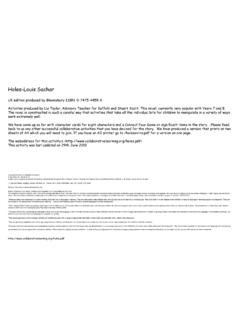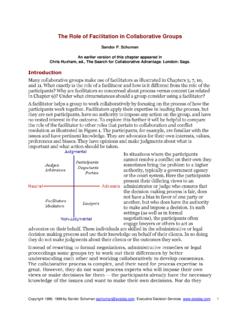Transcription of Common Problems & Collaborative Solutions
1 Common Problems & CollaborativeSolutionsOEM-Supplier Relationships and the Wisconsin Manufacturing Partnership sSupplier Training ConsortiumCommon Problems & Collaborative Solutions :OEM-Supplier Relationships and the Wisconsin Manufacturing Partnership s Supplier Training ConsortiumJeffrey RickertJoel RogersDarya VassinaJosh WhitfordJonathan ZeitlinJune 2000 Center on Wisconsin StrategyUniversity of Wisconsin-Madison, 1180 Observatory Drive, Madison, WI 53706-1393 TEL 608-263-3889 FAX 608-262-9046 INTERNET of ContentsExecutive iPolicy Recommendations .. Growing Importance of Suppliers: A Mixed Blessing .. 3 III. Supplier Management & Procurement Strategies ofWisconsin OEMs .. 7 Common Goals, Different Paths .. 7 The Firms .. 9 John Deere .. 9 Trane Corporation .. 10 Harley-Davidson .. 12 Case Corporation.
2 14 Mercury Marine .. 15 Ariens Corporation .. 16 Conclusions: Commonalities and Differences .. 18IV. Barriers to Supplier Development .. 21 Price Reduction Pressures .. 21 Shifting Costs to Suppliers .. 23 Abusing Trust .. 24 Organizational Obstacles to Collaboration: Staff Turnover, Communication Barriers,and Corporate-Plant Disjunction .. 24 Conclusions: The Limits of Individual Strategies .. WMEP Supplier Training Consortium: Promise andPerformance .. 27 Mission .. 27 Origins, Goals, and Structure .. 28 Participants Perceptions and Assessment .. 29 Outcomes: Improvements in Supplier Performance .. 30 Changing Administrative and Governance Arrangements .. 31VI. Conclusions and Recommendations .. 33 Potential Contributions .. 33 Policy Recommendations .. 34 Issues for Further Research .. 36 References.
3 39In 1998 six Wisconsin original equipment manufacturers (OEMs) John Deere, TraneCorporation, Harley Davidson, Case Corporation, Mercury Marine, and AriensCorporation together with the Wisconsin Manufacturing Extension Partnership(WMEP) set up the Supplier Training Consortium (STC). The objective was to improve theperformance of Wisconsin small and medium-sized enterprises (SMEs) through problem -oriented training, leading to gains for both the OEMs and their suppliers. This goal derivesfrom the OEMs pressing need to maximize the effectiveness of a vertically-disintegratedstructure, with its advantage of flexibility and simultaneous difficulty of continuous cost andquality controls over suppliers (Section II). At the same time it addresses SMEs needs foraffordable quality training and development, thus aiming to increase productivity andenhance companies strategic capacities in the long report examines individual OEMs supplier management strategies, focusing oncommonalities and differences in their approach to broadly similar Problems associated withsupply-chain rationalization (Section III).
4 While all the OEMs in the study aim at getting theirproducts quicker to the customer by trimming supply chains, establishing closerrelationships with suppliers, and assisting them in performance improvement, each OEMfollows a different path, depending on its size, corporate structure, products, and variations in turn shape interactions between OEMs and their suppliers, influencingopenness, closeness, trust, and ultimately, to improved supplier performance and more effective and mutually beneficialcollaborative relationship between OEMs and SMEs arise both from suppliers difficulties inadopting more advanced production practices and from OEMs own behavior. Thus, OEMsidentify the following problem areas in their relations with suppliers: high cost pressuresand suppliers inability to provide regular price reductions; price reductions as a constrainton suppliers investments in improvements; difficulty in controlling quality, delivery and timeto market; inability of suppliers to achieve improvements independently; and insufficientsupport for workforce development.
5 However, as the report s findings indicate (Section IV),OEMs can also impose considerable constraints on effective supplier development andcollaborative relationships. Some of these serious obstacles are created by OEMs unrelenting pressures for price reduction; shifting costs to the suppliers; abusing trust, andorganizational inconsistencies, such as high staff turnover, communication barriers andabsence of strategic fit between corporate and plant-level supply chain SummaryiCommon Problems & Collaborative SolutionsiiThese Common Problems point to the limits of individual OEM strategies inpromoting supplier development. Therefore, as argued in Section V, a multi-firm, public-private partnership such as the WMEP STC can play a positive role in overcoming many ofthose limitations through Collaborative efforts, sharing of costs and benefits, and leveragingof public funds.
6 Since the Consortium is a relatively new initiative, the results of its activityto date are mixed. Such positive outcomes as affordable cost and high quality of training,improved customer service and productivity are frequently undercut by weaknesses in theplanning and design of training , the WMEP STC has considerable potential for serving the needs ofOEMs and their suppliers. Recent structural changes in the STC s governance, notably thetransfer of its management from John Deere to the WMEP, while raising some concerns,assure an equal standing for all OEMs within the Consortium, increasing their contributionto the planning and implementation of training activities, as well as sharing the responsibilityfor the outcomes. In addition, the WMEP s leading administrative role enables it to serve asan honest broker discouraging opportunistic behavior by member firms and ensuring thatthe costs and benefits of consortium activities are shared out fairly among the WMEP s Supplier Training Consortium can assist participants in developingcollaborative Solutions to Common Problems and strengthening the state s supplier base byperforming three interrelated functions: facilitating information flow; sharing out the costsand benefits of widely needed services; and promoting mutual RecommendationsFurther changes in program design and governance may be necessary for theconsortium to realize its potential contributions to strengthening the state s supplier base.
7 Inparticular, to enhance the STC s capacities to facilitate information flow and promote mutuallearning among participants we recommend the following measures:1. More systematic efforts to incorporate supplier voice into the training anddevelopment process. These could include: development of training needs analysis instruments to assist suppliers in selectingappropriate courses; recruitment of supplier representatives onto the STC s governing body andcurriculum development committee; establishment of a regular OEM-supplier forum within the consortium forexchange of information and views among participating firms, along the lines ofthe individual supplier advisory councils maintained by several OEMs such asTrane and Greater attention to encouraging cross-firm learning and networking amongsuppliers through steps such as: inclusion of employees from multiple suppliers on training courses whereverpossible; creation of supplier forums and/or working groups for exchange of experiencesand joint problem -solving by SMEs Summaryiii3.
8 Increased emphasis on alignment of performance expectations and supplierdevelopment practices among OEMs through: enhanced efforts to design a Common curriculum of emphasis for supplier trainingrather than multiplying courses to fit individual OEM needs; exploration of ways to harmonize supplier qualification and certification Moreover, as a multi-firm public-private partnership, the WMEP s STC could helpindividual participants resolve internal organizational dilemmas that hinder theirsupplier development efforts in a number of ways: The STC can continue to provide an external support network for the supplierdevelopment function within participating OEMs. The STC could encourage participating OEMs to draw up a Common code of goodsupplier relations practice to stimulate the identification and diffusion of goodpractice among participating OEMs, while also guiding suppliers towards meetingtheir Common performance expectations.
9 Implementation of this code of practice within the STC could be assessed byindependent third-party monitoring. As proposed in the National Association ofPurchasing Managers (NAPM)-National Institute of Standards and Technology (NIST) sdraft White Paper on Supplier Development (NAPM-NIST, 1999), evaluation of OEM-supplier relations could be conducted on an anonymous third-party basis by theCenter on Wisconsin Strategy (COWS), while assessment of training project impactcould be conducted by the University of Wisconsin-Madison s Center for QuickResponse Manufacturing or a similar not-for-profit organization. Participating OEMs found to be in breach of the consortium s code could be asked tosubmit plans for correcting the identified Problems within a reasonable time cases of persistent uncorrected breaches of the code, consortium members and theMEP could then consider a range of possible sanctions, including loss of access topublicly subsidized supplier training.
10 The third-party monitoring process could be harnessed to mutual learning throughbenchmarking of supplier training practices and related research on OEM-supplierrelations, thereby providing a systematic mechanism for generating improvements tothe STC s curricular offerings and code of good practice. A larger pilot supplier development initiative could be implemented by OEMs andMEPs across a number of states, including Illinois as well as Wisconsin, and ifsuccessful, rapidly extended to a national scale through joint endorsement by NAPMand NIST s MEP IntroductionT he story can be told simply enough. Nearly two decades ago, original equipmentmanufacturers (OEMs) undertook a new strategy that made suppliers moreimportant to their operations. A Common problem for OEMs emerged when itbecame apparent that suppliers were in large part not ready to meet these new pressures and the structure of their business models made it difficult forOEMs individually to solve the resulting problem .

















